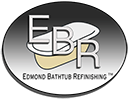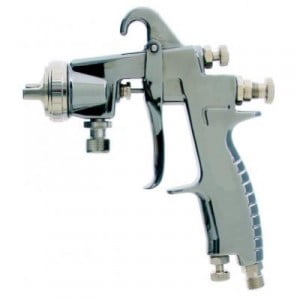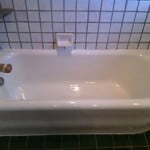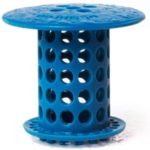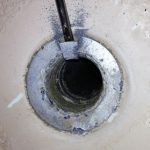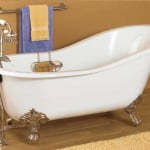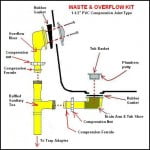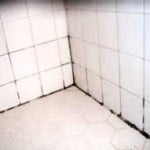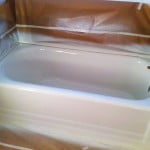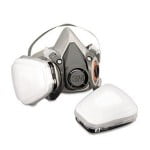The best High-Velocity Low-Pressure paint spraying system needs to be simple, efficient, easy to clean and have parts readily available. We have found that the Fuji line of HVLP spray gun equipment meets and exceeds our needs for a perfect finish.
The Fuji systems are easy to operate, clean and need very little maintenance. Parts are easy to come by, Fuji stands behind their products and best of all, you get more for your money with these inexpensive systems that pay for themselves in a job or two. This is why we believe the Fuji line are the best HVLP spray guns for refinishing.
Table of Contents
How to Set Up a HVLP Spray Gun
HVLP Spray Gun Troubleshooting
HVLP Spraying Equipment
Consisting of an HVLP Spray Gun, Hose and Turbine. The Fuji HVLP spraying system is a simple three-piece setup. The advantages of having a turbine over a compressor are:
- No water condensation in the compressor to drain or dry out
- No compressor oil contamination
- No pressure regulator and check valve to maintain or adjust
- Light-weight and a compact mobile spray system
Best HVLP Spray Gun Systems
We prefer the bottom feed, 1-quart pot guns. They are easier for us to handle, clean up and we just don’t need the top feed feature. However, we are very pleased with the performance of this model.
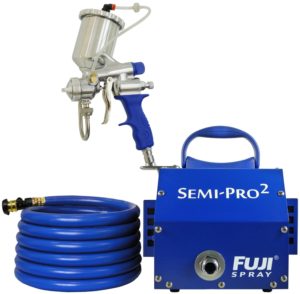
HVLP Spray Gun Reviews- Fuji Semi-Pro 2
“It is the best HVLP Spray system what you can buy for that money.
I am very pleased with quality and simplicity of use.” Ivan M.
“Fuji, the premier makers of HVLP systems, has done it again by producing an outstanding all-in-one system aimed at the DIY’er looking to produce professional results without taking out a second mortgage. The 1400 Watt motor, sturdy airline, and aluminum gun with its silky-smooth action, just ooze class. Take my word for it: If you’re in the market for an affordable, all-in-one HVLP system, look no further (and if you’re lucky enough to find it during Amazon’s Daily Deals you better thank your lucky stars.” Steve B.
How Do HVLP Spray Guns Work?
- High Volume Low Pressure. Compared to a compressor fed conventional spray gun, the HVLP spray gun uses less pressure. Usually between 1 and 10 psi but typically between 4-8 psi. The volume of the air is controlled on the gun. With much less pressure flowing through the gun, more paint is able to adhere to the working surface instead of bouncing off and filling the room with overspray.
- Instead of a compressor, a turbine is used to supply air. The turbine supplies a constant pressure and volume of air.
- With less spray bounce back the transfer efficiency can be between 70% and 90% compared to a conventional high-pressure spray gun at 25% to 50%.
HVLP Sprayer Advantages
- Inexpensive to purchase and maintain.
- Better paint transfer coverage saves money in product and solvents
- Better for the immediate spraying environment as well as the environment in general
- HVLP spray gun systems that are properly adjusted give a better quality of finish due to less over-spray filling the room and falling on the painted surfaces
- No risk of condensed water or compressor oil contamination
- Jobs are faster due to a higher transfer efficiency
- These systems are light-weight and mobile
- Air volume always stays the same
- Pressure and air volume is at an optimized ratio
- HVLP spray guns can spray a range of product’s viscosity
- Easy cleanup
How to Set Up an HVLP Spray Gun
For the most part, using your HVLP Spray Gun is the same as using a conventional compressor high-pressure system. When you are just getting used to your equipment, set up a cardboard test area and balance your air flow and fluid needle.
The fluid needle adjustment allows more or less material to flow through your spray gun. The air flow adjustment determines how finely atomized your material is as it leaves the gun.
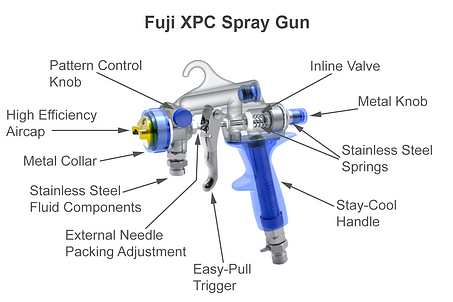
HVLP Spray Gun Adjustments
You have three adjustments on your paint gun. Your turbine pressure is a constant. On your gun, you adjust fluid flow past the needle, air volume, and fan width.
On your test board open your air volume up to max. Open your fluid adjustment until you feel comfortable with the speed you must make your passes. Set your fan width to about 6″-8″ wide and stay between 8″-12″ from the surface you are painting. Lower your air volume until the atomizing (droplets) of your paint becomes too coarse for your finish/preferences.
HVLP Spray Gun Painting Tips
A good needle set size for spraying materials that are the viscosity of bathtub coatings is the general purpose #3 also known as 1.3mm. Make sure your aircap, needle, and nozzle all match.
Spraying too close to your surface causes:
- excessive wetting of your application
- the inability of paint particles to separate effectively
- solvents to be trapped in the finish
- an uneven film thickness
- slow dry and cure times
Spraying too far from your surface causes:
- too much material and solvent to be lost in flight
- unwanted rapid drying time (roughness, dryness)
- an uneven film thickness
- overlap passes to not blend into each other
- the possibility of needing to apply more coats of material
Proper spraying distance causes:
- the best solvent loss in flight
- correct drying and curing speed
- an even film thickness
- allows the paint to adhere correctly
Most manufacturers recommend between 8-12 inches. Over 12″ is getting too far away. Under 8″ and you are looking for a run or sag…

HVLP Spray Gun Care
If you are using your sprayer every day you may be able to get by with weekly cleanings depending on how much paint you are running through the gun. If this is the case, after finishing the job empty all the paint out of the gun. Add wash thinner and shake the spray gun for a bit.
Empty this thinner out and add more clean wash thinner. Attach the gun to your turbine and spray out the remaining thinner. Repeat until the gun is spraying clean thinner. Wipe the spray gun down with thinner and make sure the gasket where the pot meets the gun is clean. Store the gun not attached to the pot.
If the spray gun is to be stored after use or when it is time to thoroughly clean up, take the gun apart and soak it in wash thinner. Use a paint sprayer brush kit and remove all paint internally and externally.
When you replace the fluid needle upon re-assembly, add a small amount of petroleum jelly to lubricate the needle as it goes through the Teflon packing. Most manufacturers recommend disassembling and cleaning after every use. This, of course, would be ideal.
- Remove the cup and wipe it down
- Remove the fluid control knob, spring and fluid needle
- Remove the front cap, nozzle, and tip
- Make sure the air holes on the cap are clean
- Run a cleaning brush through all internal passages
- Lubricate the fluid needle with a very small amount petroleum jelly before assembly
- Blow out any remaining solvent
- Store the gun and cup unattached to add life to the gasket
HVLP Spray Gun Troubleshooting
Common HVLP Spray Gun Problems
- Cup is leaking at the gasket. Often this is not the gaskets fault. Check the ears on the cup and make sure they are not bent from over-tightening.
- Orange Peel is usually caused by laying material on too thick at once. It can also be caused by using too hot of a reducer or shooting too far from the surface.
- Runs and Sags are caused by holding the spray gun too close to the surface, not moving fast enough or shooting too thin of paint.
- Solvent Pops and Pinholes come from solvents that are trapped by spraying too thick of a coat and/or the gun is too close during the pass.
- Fish Eyes are almost always the result of a speck of contamination, a pinhole in the surface or a dust/debris speck.
- Blistering usually happens when incompatible products are mixed or the top coat and bottom coat are incompatible. Water contamination could be the culprit.
- Dry Spray is the result of shooting too far away or using too hot of a reducer
- The material is not flowing well can be caused by a dirty gun, too thick of material or the flow knob or air volume knob is mal-adjusted.
- Paint is dripping from the trigger area. The Teflon packing is worn out or the packing nut is too loose. Gently tighten the packing nut.
- Paint is dripping from the tip. Wrong size or worn out needle or dirty spray gun. Packing nut could be too tight or dirty. Sometimes you can stretch the needle spring to get by (adds more pressure to the needle).
- The spray is pulsating. Something is loose. Check packing nut. Check cup seal. Trash in the gun.
- Over-spray comes from too thin of material, air flow set too high, too much paint flow, shooting from too far away and windy environments.
- Paint Spitting is usually caused by too thick of material, a nozzle and needle that are too small, or a leak either at the cup or somewhere else. Check packing nut tightness.
- Bad patterns are the result of a dirty cap and nozzle or the wrong needle and nozzle combination.
- Excessively Hot Turbine Air comes from a clogged filter on the turbine. If the air flow is low then check the filter and make sure the hose isn’t kinked.
